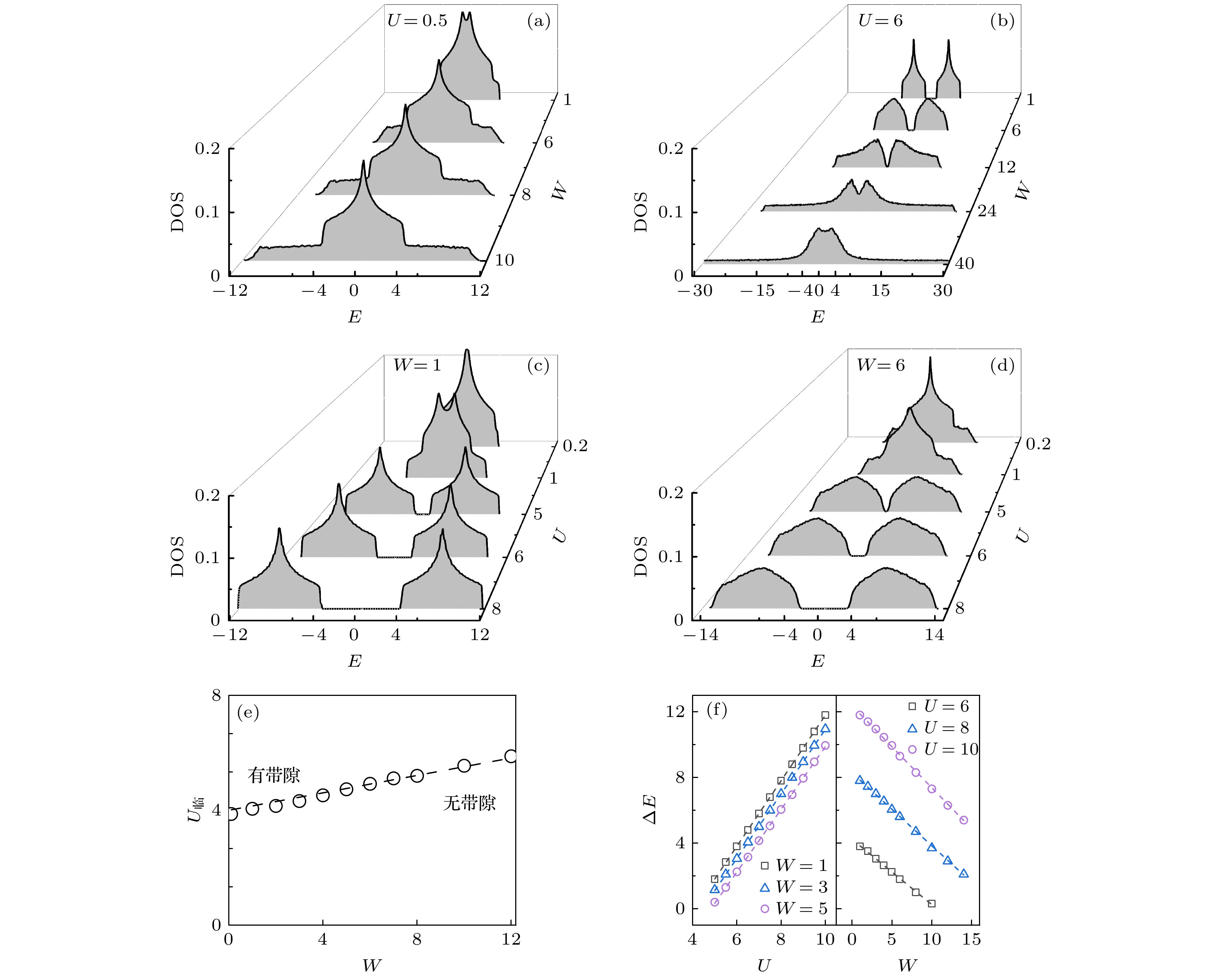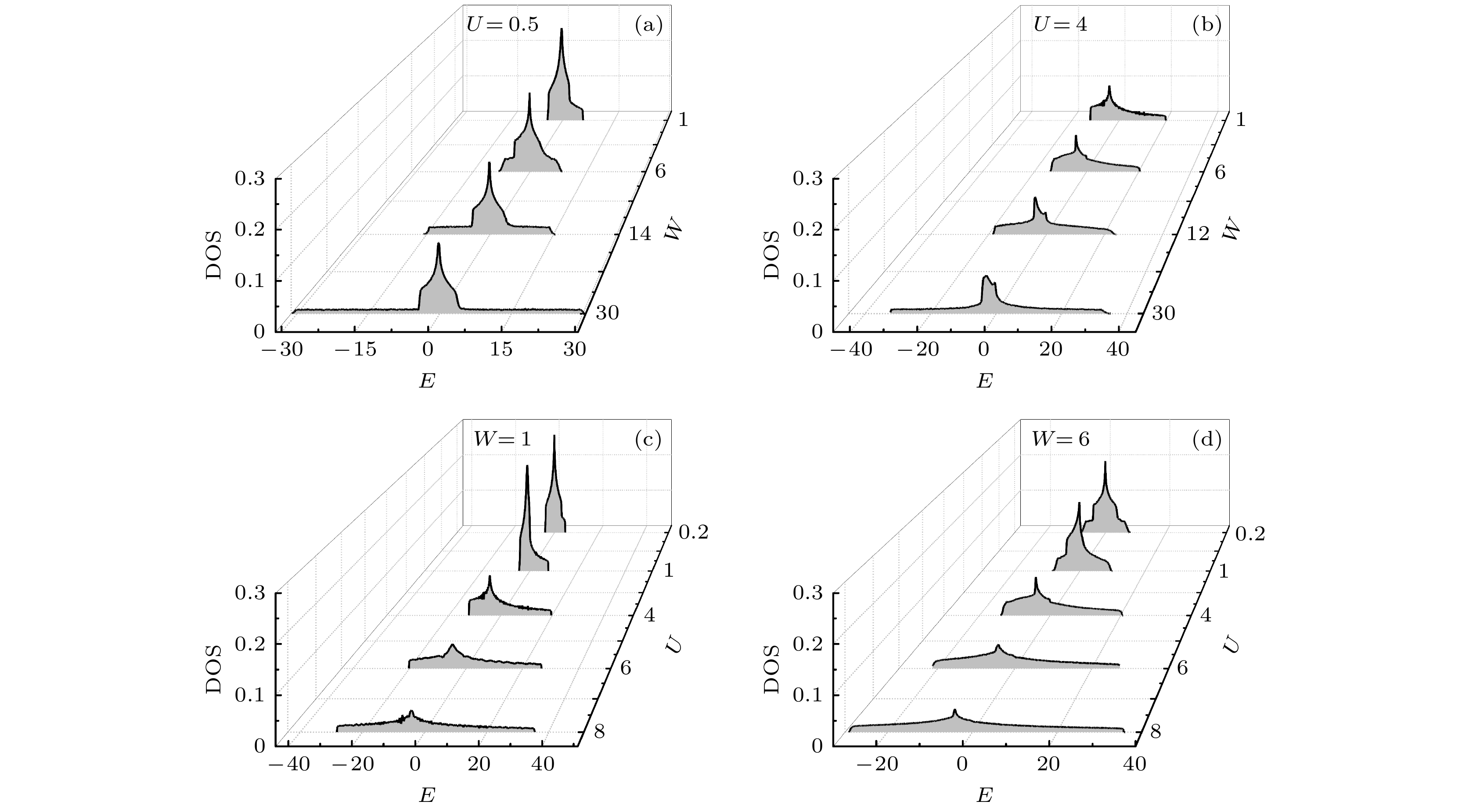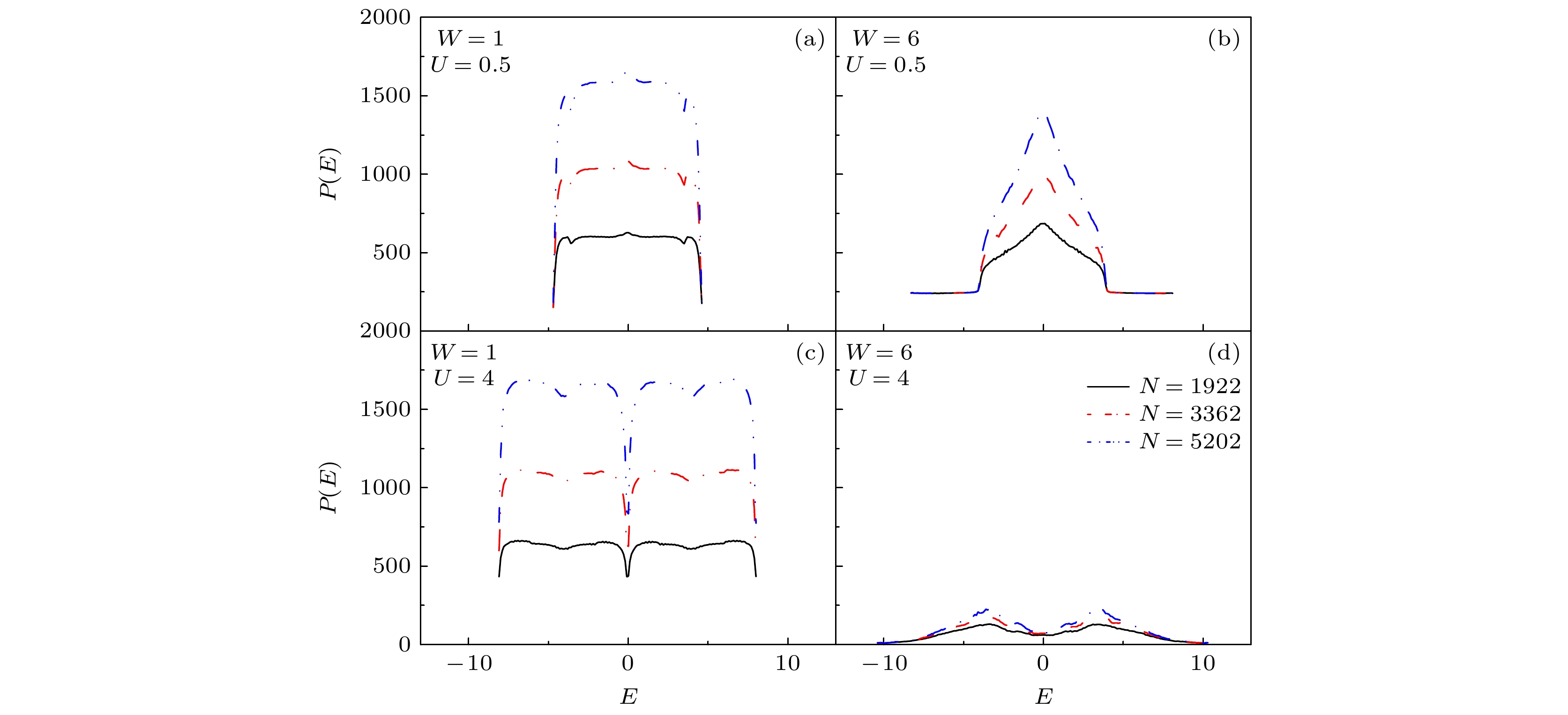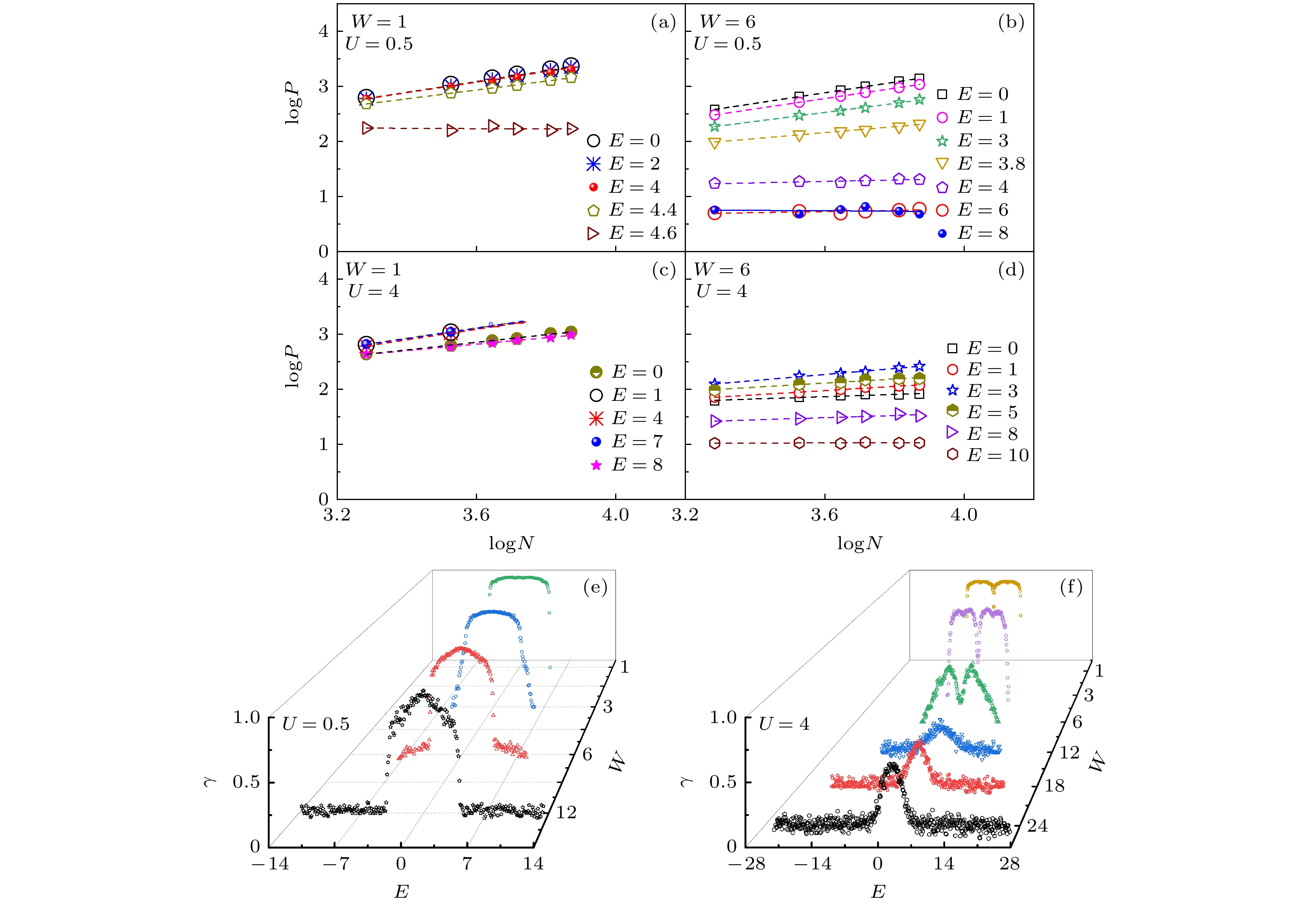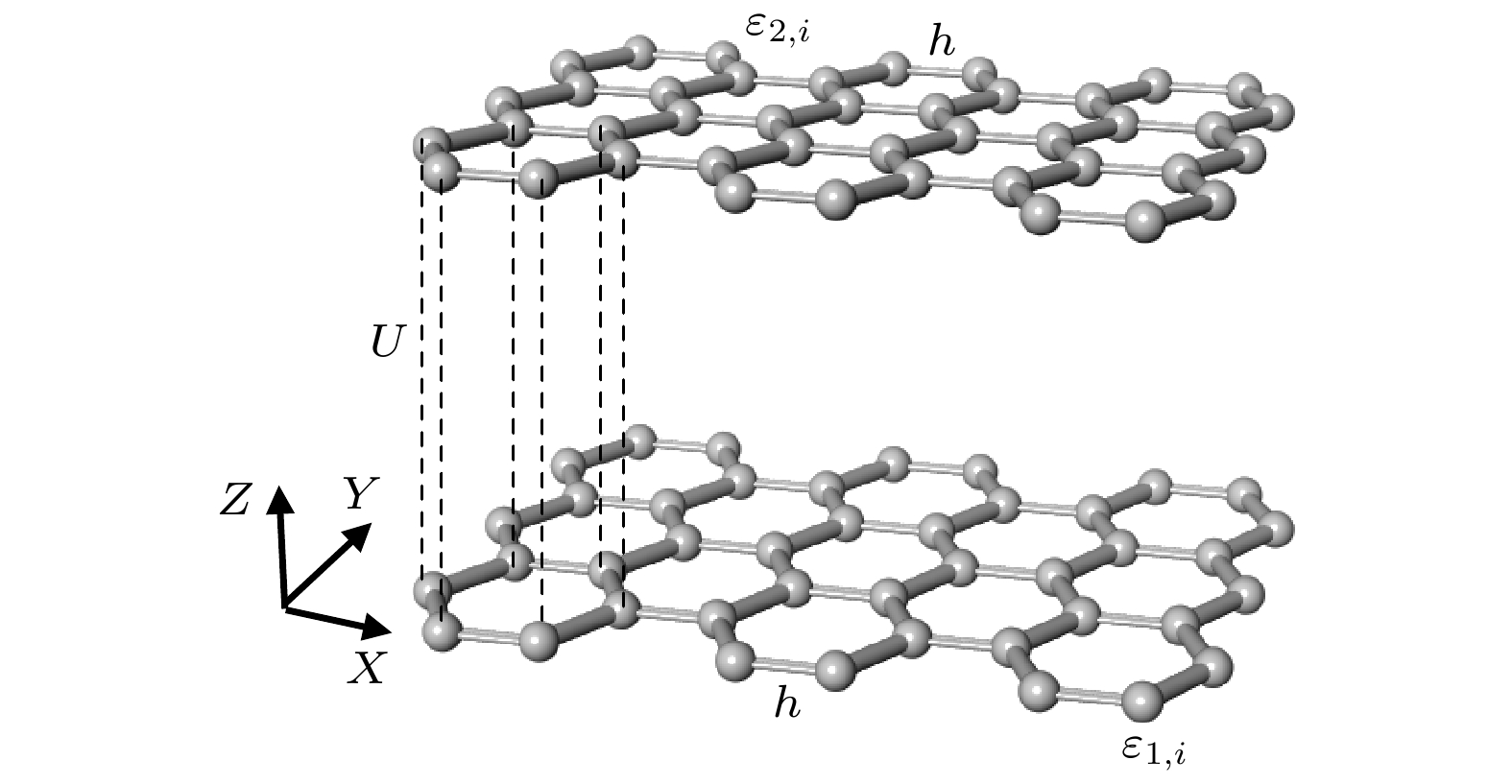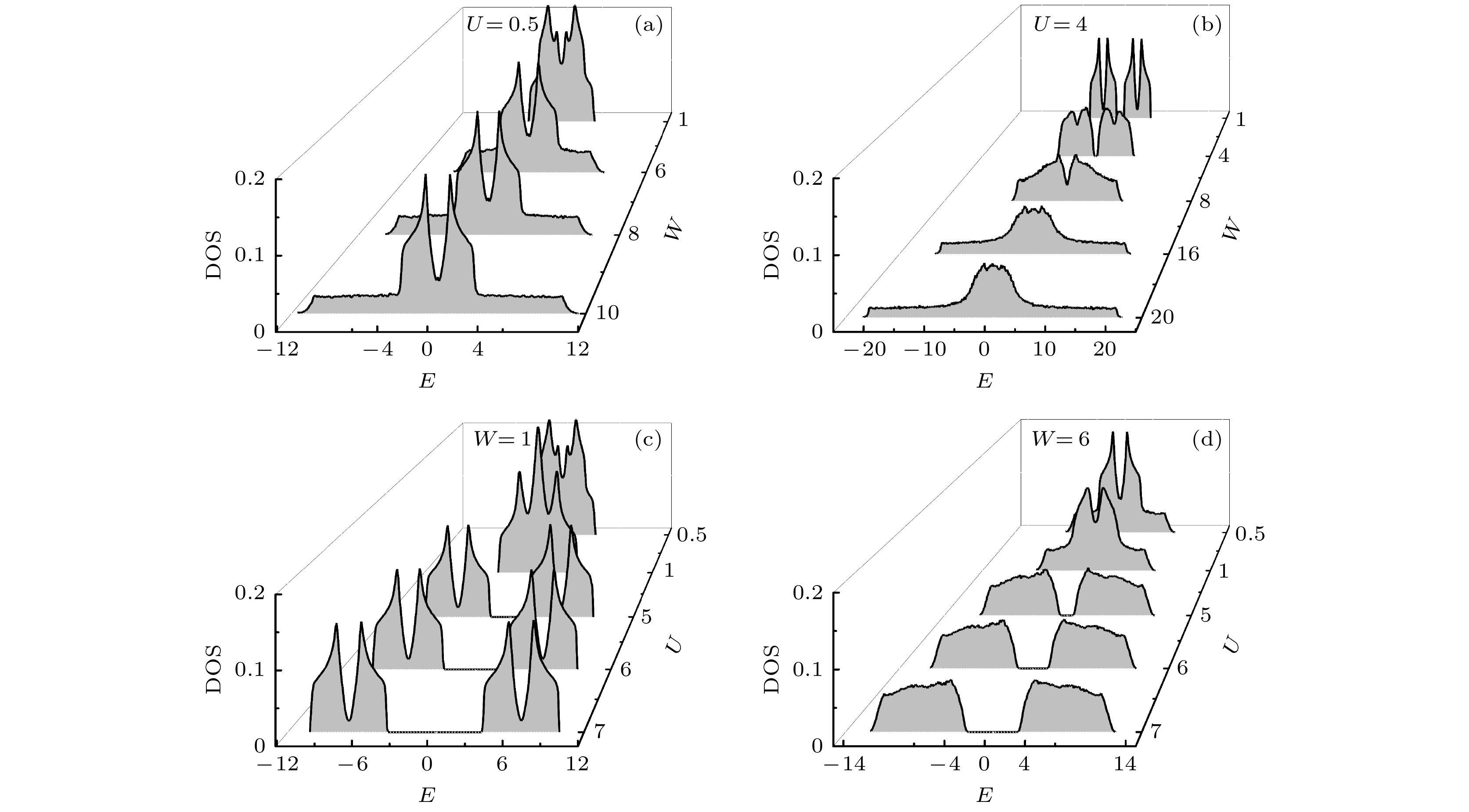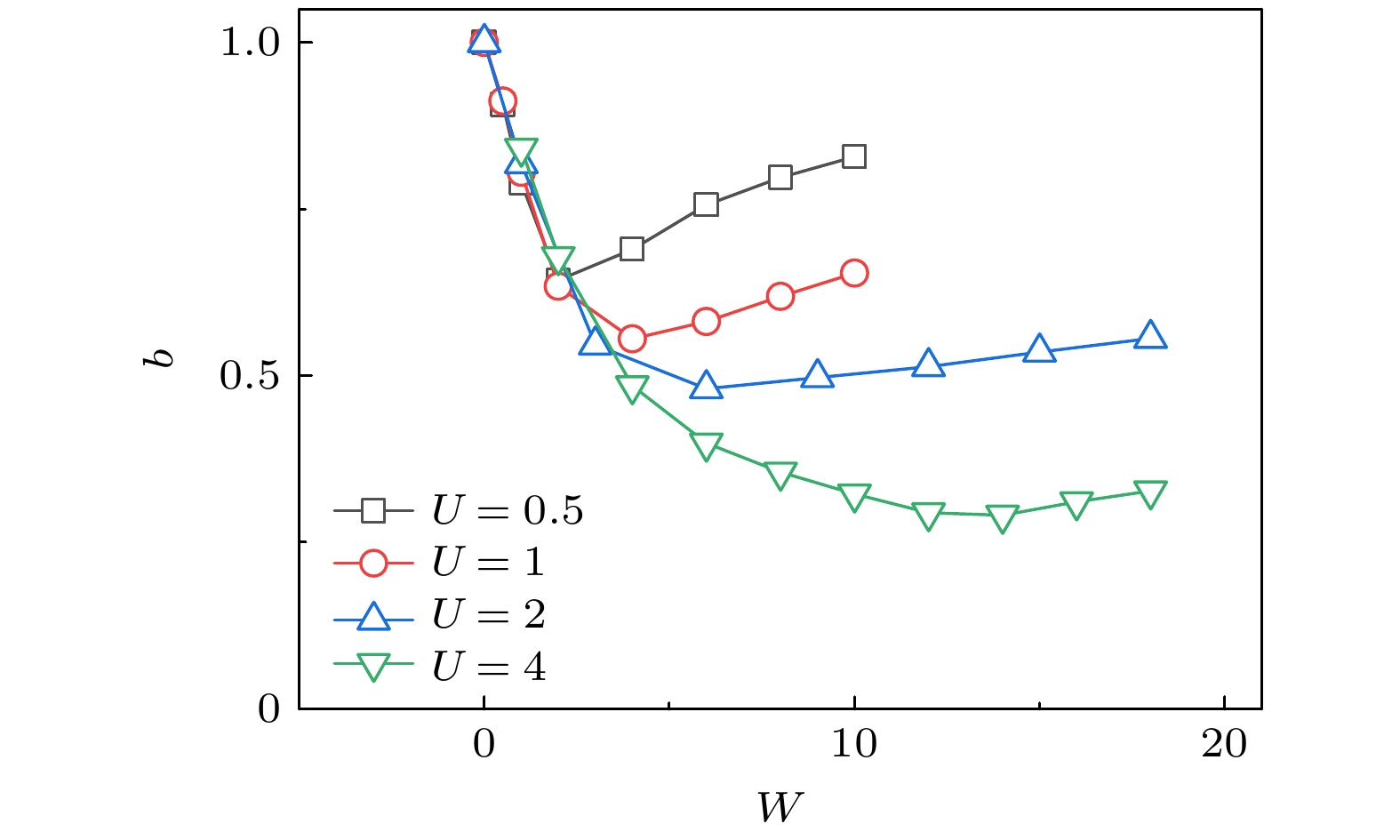-
In the framework of the electronic tight-binding model of order-disorder separated (ODS) bilayer square lattice (BSL) and by calculating the density of states (DOS), participation number of eigen-wavefunctions and quantum diffusion, we systematically study the effects of stacking interface structure, strength of interlayer coupling and degree of disorder on the electron transport properties of order-disorder separated two-dimensional bilayer systems. Our results show that for the ODS-BSL of AA-stacking in the regime of weak coupling, the ODS-BSL always possesses a single energy band with localized states in its band tail, and extended states or critical states similar to the extended ones in the band center region with persistent metal-insulator transitions and associated mobility edges under strong disorder. In the regime of strong coupling, weak disorder leads the critical states to exist in its band tails and extended states to occur in the band center regions, while strong disorder results in the formation of a single band due to the overlapping of the coupling-induced two bands with localized states in the band tails and critical states in the band center region with increasing participation numbers as disorder increases. The ODS-BSL of AB-stacking always possesses a single band and supports extended states and critical states in its band center region, regardless of the strengths of interlayer coupling and disorder. In both ODS-BSL systems of AA- and AB- stackings, quantum diffusion undergoes an anomalous transition from weakening to enhancing behaviors as disorder increases. In the AA-stacking ODS-BSL of weak coupling, AA-stacking ODS-BSL of weak disorder and the AB-stacking ODS-BSL, quantum diffusion exhibits super-diffusion due to the contribution of extended states and the critical states similar to extended ones. In the AA-stacking ODS-BSL of strong coupling, quantum diffusion undergoes sub-diffusion under strong disorder due to the existence of critical states. The numerical results also show that the order-disorder separated (ODS) bilayer hexagonal lattice exhibits the same behaviors as those revealed in ODS-BSL systems.
[1] Novoselov K S, Geim A K, Morozov S V, Jiang D, Zhang Y, Dubonos S V, Grigorieva I V, Firsov A A 2004 Science 306 666
 Google Scholar
Google Scholar
[2] Novoselov K S, Jiang D, Schedin F, Booth T J, Khotkevich V V, Morozov S V, Geim A K 2005 Proc. Natl. Acad. Sci. USA 102 10451
 Google Scholar
Google Scholar
[3] Geim A K, Grigorieva I V 2013 Nature 499 419
 Google Scholar
Google Scholar
[4] Novoselov K S, Mishchenko A, Carvalho A, Neto A C 2016 Science 353 aac9439
 Google Scholar
Google Scholar
[5] Zhu Y, Ji H, Cheng H M, Ruoff R S 2018 Natl. Sci. Rev. 5 90
 Google Scholar
Google Scholar
[6] Bian R, Li C, Liu Q, Cao G, Fu Q, Meng P, Zhou J, Liu F, Liu Z 2021 Natl. Sci. Rev. 0 nwab164
 Google Scholar
Google Scholar
[7] Cao Y, Fa Temi V, Fa Ng S, Watanabe K, Taniguchi T, Kaxiras E, Jarillo-Herrero P 2018 Nature 556 43
 Google Scholar
Google Scholar
[8] Lu X, Stepanov P, Yang W, Xie M, Efetov D K 2019 Nature 574 653
 Google Scholar
Google Scholar
[9] 吕新宇, 李志强 2019 68 220303
 Google Scholar
Google Scholar
Lü X Y, Li Z Q 2019 Acta Phys. Sin. 68 220303
 Google Scholar
Google Scholar
[10] Nimbalkar A, Kim H 2020 Nano-Micro Lett. 12 20
 Google Scholar
Google Scholar
[11] 何龙, 宋筠 2013 62 057303
 Google Scholar
Google Scholar
He L, Song Y 2013 Acta Phys. Sin. 62 057303
 Google Scholar
Google Scholar
[12] Rozhkov A V, Sboychakov A O, Rakhmanov A L, Nori F 2016 Phys. Rep. 648 1
 Google Scholar
Google Scholar
[13] Conte F, Ninno D, Cantele G 2019 Phys. Rev. B 99 155429
 Google Scholar
Google Scholar
[14] Anderson P W 1958 Phys. Rev. 109 1492
 Google Scholar
Google Scholar
[15] Abrahams E A, Anderson P, Licciardello D, Ramakrishnan T 1979 Phys. Rev. Lett. 42 673
 Google Scholar
Google Scholar
[16] Addou R, Colombo L, Wallace R M 2015 ACS Appl. Mater Interf. 7 11921
 Google Scholar
Google Scholar
[17] Fernández-Serra M, Adessi C, Blase X 2006 Phys. Rev. Lett. 96 166805
 Google Scholar
Google Scholar
[18] Yang K W, Chen X Y, Zheng Z H, Wan J Q, Feng M, Yu Y 2019 J. Mater. Chem. A 7 3863
 Google Scholar
Google Scholar
[19] Xu D, Liu H, Iv V S, Song J, Jiang H, Sun Q F, Xie X C 2013 J. Phys. Condens Matter 25 105303
 Google Scholar
Google Scholar
[20] Bagci V, Krokhin A A 2007 Phys. Rev. B 76 134202
 Google Scholar
Google Scholar
[21] Zhang W, Yang R, Ulloa S E 2009 Phys. Rev. E 80 051901
 Google Scholar
Google Scholar
[22] Markussen T, Rurali R, Brandbyge M, Jauho A P 2006 Phys. Rev. B 74 245313
 Google Scholar
Google Scholar
[23] Akguc G B, Gong J 2009 Phys. Rev. B 81 117402
 Google Scholar
Google Scholar
[24] Menezes M G, Nero J D, Capaz R B, Rego L 2010 Phys. Rev. B 81 117401
 Google Scholar
Google Scholar
[25] Sun L, Li S, Su Y, He D, Zhang Z 2019 Appl. Surf. Sci. 463 474
 Google Scholar
Google Scholar
[26] Abhinav S, Muttalib K A 2019 J. Phys. Communica. 3 105010
 Google Scholar
Google Scholar
[27] Zhong J, Stocks G M 2006 Nano Lett. 6 128
 Google Scholar
Google Scholar
[28] Vogel E 2007 Nature Nanotechnol. 2 25
 Google Scholar
Google Scholar
[29] Xiong, Gang 2007 Phys. Rev. B 76 153303
 Google Scholar
Google Scholar
[30] Wei Z, Rong Y, Yi Z, Duan S, Ping Z, Ulloa S E 2010 Phys. Rev. B 81 214202
 Google Scholar
Google Scholar
[31] Ganguly S, Maiti S K 2020 J. Phys. D: Appl. Phys. 53 025301
 Google Scholar
Google Scholar
[32] Zhong J X, Stocks G M 2007 Phys. Rev. B 75 033410
 Google Scholar
Google Scholar
[33] Patrick A, Lee T, Ramakrishnan V 1985 Rev. Modern Phys. 57 287
 Google Scholar
Google Scholar
[34] Zhong J X, Mosseri R 1995 J. Phys. Condensed Matter 7 8383
 Google Scholar
Google Scholar
[35] Schulz-Baldes H, Bellissard J 1998 Rev. Mathema. Phys. 10 1
 Google Scholar
Google Scholar
-
图 1 有序-无序双层耦合正方晶格模型图(
$\varepsilon _i^{\left( 2 \right)}$ ,$\varepsilon _i^{\left( 1 \right)}$ )分别表示上、下层格点能,$ U $ 和h分别表示层间与层内最近邻格点跃迁能) (a) AA堆垛 (上层原子位于下层原子正上方); (b) AB堆垛 (上层原子位于下层正方格子中心正上方)Figure 1. Schematic illustration of the order-disorder coupling system of bilayer square lattices (
$\varepsilon _i^{\left( 2 \right)}$ ,$\varepsilon _i^{\left( 1 \right)}$ ) are onsite energies of upper and lower layers,$ U $ and h represent the hoping energy of inter-layer and intra-layer respectively): (a) AA stacking (the upper atom is directly above the lower atom); (b) AB stacking (the upper atom is located directly above the center of the lower square).图 2 双层耦合正方周期晶格的能带与DOS (a), (b) 分别为
$ U $ = 1和$ U $ = 6的AA型耦合系统的能带图; (c) AA型耦合晶格的DOS 随$ U $ 的变化; (d), (e) 分别为$ U $ = 1和$ U $ = 6的AB型耦合系统的能带图; (f) AB型耦合晶格的DOS随$ U $ 的变化Figure 2. Energy spectra and DOS for the periodic coupling system of bilayer square lattices: (a), (b) Energy spectra for the coupling system of AA stacking with
$ U $ = 1 and$ U $ = 6, respectively; (c) variation of DOS with$ U $ for the coupling system of AA stacking; (d), (e) energy spectra for the coupling system of AB stacking with$ U $ = 1 and$ U $ = 6, respectively; (f) the variation of DOS with$ U $ for the coupling system of AB stacking.图 3 AA型堆垛有序-无序双层耦合正方晶格电子能谱 (a)—(d) DOS随
$ U $ 和$ W $ 的变化; (e) 产生带隙所对应的$ U $ 和$ W $ (空心圆)及其拟合线(虚线); (f) 带隙宽度$ \Delta E $ 随$ U\rm{和}W $ 的变化, 左图为$ \Delta E $ (空心符号)随$ U $ 的变化及其拟合线(虚线), 其中$ W $ = 1, 3, 5分别对应斜率1.99, 1.96, 1.90; 右图为$ \Delta E $ (空心符号)随$ W $ 的变化及其拟合线(虚线), 其中$ U $ = 6, 8, 10分别对应斜率–0.40, –0.44, –0.50Figure 3. Energy spectra for the order-disorder bilayer coupling system of square lattices with AA stacking: (a)–(d) Changes of the DOS for different
$ U $ and$ W $ ; (e) the relationship of$ W $ and$ U $ (open circles) for the band-gap opening with the linear fitting (dashed line); (f) the dependence of bandgap width$ \Delta E $ (hollow symbols) on$ U $ and W with the left panel for$ U $ with the linear fitting (dash lines), where$ W $ = 1, 3, 5 correspond to the slopes of 1.99, 1.96, 1.90, respectively, and the right panel for$ W $ with the linear fitting (dash lines), where$ U $ = 6, 8, 10 correspond to the slopes –0.40, –0.44, –0.50, respectively.图 5 AA型堆垛有序-无序双层耦合正方晶格本征态波函数分布图(其中D-L和O-L分别代表上层无序晶格和下层有序晶格) (a), (b) 分别为弱耦合系统(
$ U $ = 0.5)在弱无序($ W $ = 1)和强无序($ W $ = 10)时的带中态(E = 0.140, 0.016)和带尾态(E = 4.60, 11.46)的波函数$ {\left|\boldsymbol{\varPhi }\left(E\right)\right|}^{2} $ 分布; (c), (d) 分别为强耦合系统($ U $ = 4)在弱无序($ W $ = 1)和强无序($ W $ = 10)时的带中态(E = 3.86, –0.17)和带尾态(E = 8.08, 12.96)的波函数$ {\left|\boldsymbol{\varPhi }\left(E\right)\right|}^{2} $ 分布; 黑色表示概率大于 0.005Figure 5. Eigen-wavefunctions
$ {\left|\boldsymbol{\varPhi }\left(E\right)\right|}^{2} $ for the bilayer coupling system of square lattices with AA stacking, where D-L and O-Lrepresent the upper disordered layer and the lower ordered layer respectively: (a), (b) Eigen-wavefunctions of the eigen-states (E = 0.140, 0.016) in the spectral central region and the eigen-states (E = 4.60, 11.46) in the tail region for the weak coupling system of$ U $ = 0.5 with small disorder of$ W $ = 1 and strong disorder of$ W $ = 10, respectively; (c), (d) the eigen-wavefunctions of the eigen-states (E = 3.86, –0.17) in the spectral central region and the eigen-states (E = 8.08, 12.96) in tail region for the strong coupling system of$ U $ = 4 with small disorder of$ W $ = 1 and strong disorder of$ W $ = 10, respectively. The black color means that the values are larger than 0.005.图 6 AB型堆垛有序-无序双层耦合正方晶格的带中态和带尾态波函数分布图 (a), (b)分别为层间弱耦合(U = 0.5)时弱无序(W = 1)及强无序(W = 12)体系中带中态(E = 0.34, 0.89)及带尾态(E = 6.07, 13.50)波函数的分布; (c), (d) 分别为层间强耦合(U = 4)时弱无序(W = 1)及强无序(W = 12)体系中带中态(E = –1.98, –0.67)及带尾态(E = 20.01, 23.05)波函数的分布; 黑色表示概率大于 0.005
Figure 6. Eigen-wavefunctions of the eigen-states in the spectral central and tail regions for the order-disorder bilayer couplingsystem of square lattices with AB stacking: (a), (b) Eigen-wavefunctions of the eigen-states (E = 0.34, 0.89) in the spectral central region and the eigen-states (E = 6.07, 13.50) in the tail region for the weak coupling system of
$ U $ = 0.5 with small disorder of$ W $ = 1 and strong disorder of$ W $ = 12, respectively; (c), (d) the eigen-wavefunctions of the eigen-states (E = –1.98, –0.67) in the spectral central region and the eigen-states (E = 20.01, 23.05) in tail region for the strong coupling system of$ U $ = 4 with small disorder of$ W $ = 1 and strong disorder of$ W $ = 12, respectively. The black color means that the values are larger than 0.005.图 7 AA型堆垛有序-无序双层耦合正方晶格波函数的格点占据数
$ P\left(E\right) $ 随$ W $ 的变化情况 (a) 弱耦合系统$ U $ = 0.5; (b), (c) 强耦合系统$ U $ = 4.0Figure 7. Variation of participation number
$ P\left(E\right) $ with$ W $ for the order-disorder bilayer coupling system with AA stacking: (a) Weak coupling system of$ U $ = 0.5; (b), (c) strong coupling system of$ U $ = 4.0.图 8 AA型堆垛有序-无序双层耦合正方晶格的格点占据数
$ P(E) $ 随体系尺寸大小N的变化 (a), (b) 弱耦合系统$ U $ = 0.5;(c), (d) 强耦合系统$ U $ = 4.0.Figure 8. Variation of participation number P(E) with system size N for order-disorder bilayer coupling system with AA stacking. (a), (b) Weak coupling system of
$ U $ = 0.5; (c), (d) strong coupling system of$ U $ = 4.0图 9 (a)—(d) AA型堆垛有序-无序双层耦合正方晶格系统的带尾态和带中态中典型能量处的P(E)随N的变化, 符号对应计算结果, 虚线为对
${\text{log}}P\sim \gamma {\text{log}}N$ 的拟合线; (e), (f) 拟合指数$ \gamma $ 随能量的分布Figure 9. (a)–(d) Variation of P(E) with N for the order-disorder bilayer coupling system with AA stacking at typical energy values in the spectral tail and central regions, where symbols are the calculation results, dashed lines are the fitting results to
$ \text{log}P\sim \gamma \text{log}N $ ; (e), (f) distribution of fitting exponent$ \gamma $ with energy.图 10 (a)—(d) AB型堆垛有序-无序双层耦合正方晶格的带尾态和带中态中典型能量处的
$ P\left(E\right) $ 随N的变化, 符号对应计算结果, 虚线为对$ {\rm{log}}P \sim \gamma{ \rm{log}}N $ 的线性拟合线; (e), (f) 拟合指数$ \gamma $ 随能量的分布Figure 10. (a)–(d) Variation of P(E) with N for the order-disorder bilayer coupling system with AB stacking at typical energy values in the spectral tail and central regions, where symbols are the calculation results, dashed lines are the fitting results to
${ \rm{log}}P \sim $ $ \gamma {\rm{log}}N$ ; (e), (f) distribution of fitting exponent$ \gamma $ with energy.图 11 AA堆垛有序-无序双层耦合正方晶格中量子扩散的均方位移
$ d\left(t\right) $ (符号)及对$ d\left(t\right)\sim{t}^{b} $ 的拟合结果(虚线) (a) 弱耦合系统$ U $ = 0.5; (b) 强耦合系统$ U $ = 4; (c) 拟合指数b随无序度$ W $ 的变化Figure 11. Mean-square displacement
$ d\left(t\right) $ (symbols) of the quantum diffusion for the order-disorder bilayer coupling system of the square lattices with AA stacking and theirfitting results to$ d\left(t\right)\sim{t}^{b} $ (dash line): (a) Weak coupling system of U = 0.5; (b) strong coupling system of U = 4; (c) variation of the fitting results of b with the degree of disorder W.图 12 AB堆垛有序-无序双层耦合正方晶格中量子扩散的均方位移
$ d\left(t\right) $ (符号)及对$d\left(t\right)\sim{t}^{b}$ 拟合结果(虚线) (a) 弱耦合系统$ U $ = 1; (b) 强耦合系统$ U $ = 4; (c) 拟合指数$ b $ 随无序度$ W $ 的变化Figure 12. Mean-square displacement d(t) (symbols) of the quantum diffusion for the order-disorder bilayer coupling system of the square lattices with AB stacking and their fitting results to
$ d\left(t\right)\sim {t}^{b} $ (dash line): (a) Weak coupling system of$ U $ = 1; (b) strong coupling system of$ U $ = 4; (c) variation of the fitting results of b with the degree of disorder W.图 16 有序-无序双层耦合六角晶格结构中对不同能量处
${ \rm{l}\rm{o}\rm{g}}P\sim\gamma {\rm{l}\rm{o}\rm{g}}N$ 的拟合结果 (a) 弱耦合体系(U = 0.5)中不同W下拟合指数$ \gamma $ 随能量的分布; (b) 强耦合体系(U = 4.0)中不同W下拟合指数$ \gamma $ 随能量的分布Figure 16. Fitting results to
${\rm{l}\rm{o}\rm{g}}P\sim\gamma {\rm{l}\rm{o}\rm{g}}N$ for the order-disorder bilayer coupling system of bilayer hexagonal lattices at different energy: (a) Changes of the distribution of fitting exponent$ \gamma $ with energy for different W for weak coupling system of$ U $ = 0.5; (b) changes of the distribution of fitting exponent$ \gamma $ with energy for different W for strong coupling system of$ U $ = 4.0. -
[1] Novoselov K S, Geim A K, Morozov S V, Jiang D, Zhang Y, Dubonos S V, Grigorieva I V, Firsov A A 2004 Science 306 666
 Google Scholar
Google Scholar
[2] Novoselov K S, Jiang D, Schedin F, Booth T J, Khotkevich V V, Morozov S V, Geim A K 2005 Proc. Natl. Acad. Sci. USA 102 10451
 Google Scholar
Google Scholar
[3] Geim A K, Grigorieva I V 2013 Nature 499 419
 Google Scholar
Google Scholar
[4] Novoselov K S, Mishchenko A, Carvalho A, Neto A C 2016 Science 353 aac9439
 Google Scholar
Google Scholar
[5] Zhu Y, Ji H, Cheng H M, Ruoff R S 2018 Natl. Sci. Rev. 5 90
 Google Scholar
Google Scholar
[6] Bian R, Li C, Liu Q, Cao G, Fu Q, Meng P, Zhou J, Liu F, Liu Z 2021 Natl. Sci. Rev. 0 nwab164
 Google Scholar
Google Scholar
[7] Cao Y, Fa Temi V, Fa Ng S, Watanabe K, Taniguchi T, Kaxiras E, Jarillo-Herrero P 2018 Nature 556 43
 Google Scholar
Google Scholar
[8] Lu X, Stepanov P, Yang W, Xie M, Efetov D K 2019 Nature 574 653
 Google Scholar
Google Scholar
[9] 吕新宇, 李志强 2019 68 220303
 Google Scholar
Google Scholar
Lü X Y, Li Z Q 2019 Acta Phys. Sin. 68 220303
 Google Scholar
Google Scholar
[10] Nimbalkar A, Kim H 2020 Nano-Micro Lett. 12 20
 Google Scholar
Google Scholar
[11] 何龙, 宋筠 2013 62 057303
 Google Scholar
Google Scholar
He L, Song Y 2013 Acta Phys. Sin. 62 057303
 Google Scholar
Google Scholar
[12] Rozhkov A V, Sboychakov A O, Rakhmanov A L, Nori F 2016 Phys. Rep. 648 1
 Google Scholar
Google Scholar
[13] Conte F, Ninno D, Cantele G 2019 Phys. Rev. B 99 155429
 Google Scholar
Google Scholar
[14] Anderson P W 1958 Phys. Rev. 109 1492
 Google Scholar
Google Scholar
[15] Abrahams E A, Anderson P, Licciardello D, Ramakrishnan T 1979 Phys. Rev. Lett. 42 673
 Google Scholar
Google Scholar
[16] Addou R, Colombo L, Wallace R M 2015 ACS Appl. Mater Interf. 7 11921
 Google Scholar
Google Scholar
[17] Fernández-Serra M, Adessi C, Blase X 2006 Phys. Rev. Lett. 96 166805
 Google Scholar
Google Scholar
[18] Yang K W, Chen X Y, Zheng Z H, Wan J Q, Feng M, Yu Y 2019 J. Mater. Chem. A 7 3863
 Google Scholar
Google Scholar
[19] Xu D, Liu H, Iv V S, Song J, Jiang H, Sun Q F, Xie X C 2013 J. Phys. Condens Matter 25 105303
 Google Scholar
Google Scholar
[20] Bagci V, Krokhin A A 2007 Phys. Rev. B 76 134202
 Google Scholar
Google Scholar
[21] Zhang W, Yang R, Ulloa S E 2009 Phys. Rev. E 80 051901
 Google Scholar
Google Scholar
[22] Markussen T, Rurali R, Brandbyge M, Jauho A P 2006 Phys. Rev. B 74 245313
 Google Scholar
Google Scholar
[23] Akguc G B, Gong J 2009 Phys. Rev. B 81 117402
 Google Scholar
Google Scholar
[24] Menezes M G, Nero J D, Capaz R B, Rego L 2010 Phys. Rev. B 81 117401
 Google Scholar
Google Scholar
[25] Sun L, Li S, Su Y, He D, Zhang Z 2019 Appl. Surf. Sci. 463 474
 Google Scholar
Google Scholar
[26] Abhinav S, Muttalib K A 2019 J. Phys. Communica. 3 105010
 Google Scholar
Google Scholar
[27] Zhong J, Stocks G M 2006 Nano Lett. 6 128
 Google Scholar
Google Scholar
[28] Vogel E 2007 Nature Nanotechnol. 2 25
 Google Scholar
Google Scholar
[29] Xiong, Gang 2007 Phys. Rev. B 76 153303
 Google Scholar
Google Scholar
[30] Wei Z, Rong Y, Yi Z, Duan S, Ping Z, Ulloa S E 2010 Phys. Rev. B 81 214202
 Google Scholar
Google Scholar
[31] Ganguly S, Maiti S K 2020 J. Phys. D: Appl. Phys. 53 025301
 Google Scholar
Google Scholar
[32] Zhong J X, Stocks G M 2007 Phys. Rev. B 75 033410
 Google Scholar
Google Scholar
[33] Patrick A, Lee T, Ramakrishnan V 1985 Rev. Modern Phys. 57 287
 Google Scholar
Google Scholar
[34] Zhong J X, Mosseri R 1995 J. Phys. Condensed Matter 7 8383
 Google Scholar
Google Scholar
[35] Schulz-Baldes H, Bellissard J 1998 Rev. Mathema. Phys. 10 1
 Google Scholar
Google Scholar
Catalog
Metrics
- Abstract views: 7022
- PDF Downloads: 118
- Cited By: 0





















 DownLoad:
DownLoad:













